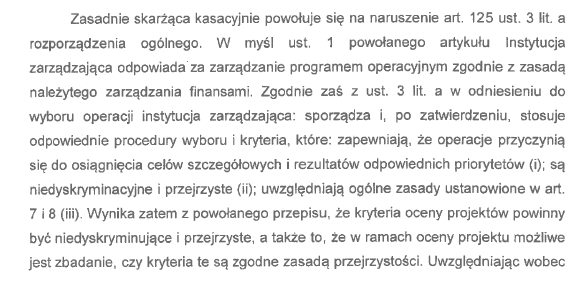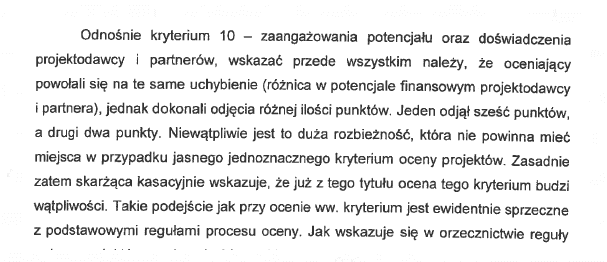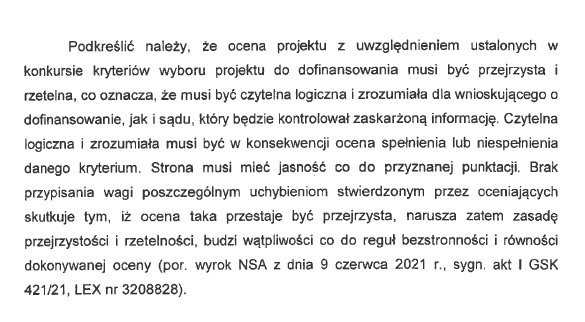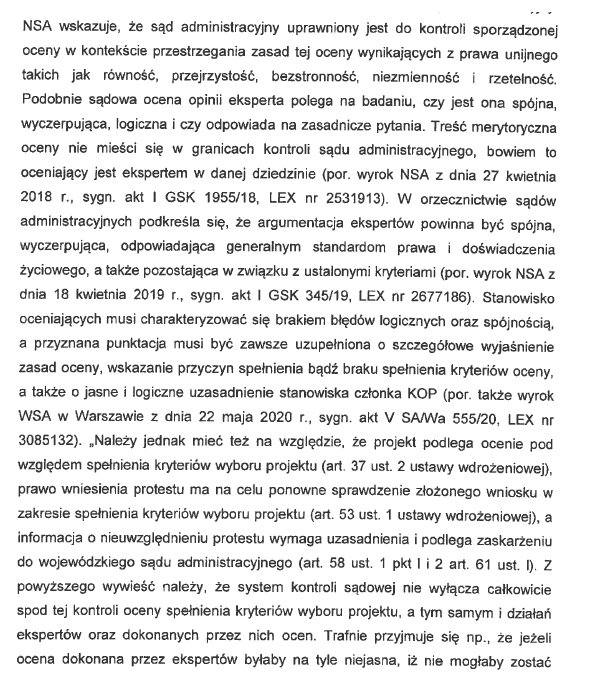In several previous posts including here: Negative assessment – How to appeal effectively? (Part I) – – Krzysztof Brysiewicz Blog (kbrysiewicz.pl)
and here: Negative assessment – how to appeal effectively? (part II) – EU funding – Krzysztof Brysiewicz Blog (kbrysiewicz.pl)
I described the principles of project assessment and ways to appeal against negative project assessments.
In this blog post, I would like to return to this topic, an occasion for which is a judgment of the Supreme Administrative Court of 16 March 2022 (ref. I GSK 361/22) in a case in which I had the pleasure of acting for the applicant. In the latest judgment, the NSA summarises certain important principles that should be observed by the institution when assessing projects, and also organises the process of checking the legality of the assessment carried out.
Defects in competition documentatio
As I have indicated in previous posts, the analysis whether the project evaluation is legal should begin with investigating whether the provisions on the basis of which the competition was conducted are compliant with the regulations. It may turn out that the criteria used to assess our project are inconsistent with the regulations in force, discriminatory or non-transparent, or disproportionate to the assumed objective. Similar flaws may be related to other provisions of the competition documentation, e.g. the provisions of the competition regulations, the rules of the evaluation committee, the criteria guide, the application template or the business plan, or the instructions to these documents, which may be unclear, imprecise or insufficient.
The Supreme Administrative Court confirmed the possibility of controlling the very provisions of the competition documentation in terms of their compliance with the law, indicating:


The NSA also stressed that "the definition of the assessment criteria should unambiguously determine what information must be provided by the applicant. This is because only a precise definition of the criteria allows the institution competent to examine the application to carry out a correct assessment. This results, inter alia, from the principle of transparency of the competition procedure. Any departure from the principle of transparency is at the same time a violation of the principle of equal treatment of all potential beneficiaries. In particular, the selection criteria for projects should be precise so that applicants have all the necessary information needed to properly understand the requirements for obtaining payments."
In the event of any conflict between the provisions of the competition dossier, the criteria shall prevai
The NSA also pointed out that when the provisions of the competition documentation contained in various documents (e.g. guidelines, regulations or instructions for filling in the application) are not unambiguous, the wording of the evaluation criteria themselves is decisive.
In case of possible contradictions in the meaning of certain terms, the description of the criterion should take precedence over e.g. the guidelines. This is convinced by the paramount importance of this factor serving as the basis for project evaluation, i.e. the criterion, in the project evaluation process. In addition, ambiguities in competition regulations concerning co-financing should not be interpreted to the detriment of the applicant, if only for the sake of fairness and transparency.
Discrepancies in assessment - when are they relevant and who decides
Such an example of a defect in documentation, which I mentioned in a previous post, is the lack of possibility to remove extreme discrepancies in the assessments of individual experts, which results in the project assessment being de facto a resultant of two fundamentally different partial assessments. Unfortunately, institutions often hide behind the very wording of the competition documentation (regulations), indicating that the procedure adopted by them for removing discrepancies exhausts the subject. In general, the wording of these provisions is such that a significant discrepancy is defined as a significant difference in points between the assessments after adding up all the partial criteria assessments, i.e. when, for example, one expert awarded 80 points and the other 120 points. However, such a definition does not exhaust the concept of „significant discrepancy”, which is particularly evident in situations where the differences between the projects amount to several points and the experts’ assessments under only one criterion may differ and in an extreme manner.
The Supreme Administrative Court also indicates in this respect that the notion of „significant discrepancy” in assessments should be referred to the specific assessment of a given project and a specific criterion. Even if, after all, the assessors award 80 points each, for example, their assessment under individual criteria may differ in an extreme manner – which should be defined as a „significant discrepancy”.


Points should be deducted for specific failure
Another important issue raised in the NSA’s judgment is the need to indicate for which deficiencies the experts deducted a specific number of points. As the NSA rightly points out, assigning the deducted points to specific failings realises the principle of assessment transparency. Subtraction of points for the so called „whole” cannot be approved without ascribing specific point weights to the deficiencies. This position is not always reflected in current case law, so it is good that the SAC has emphasised the importance of this principle.


The administrative court is not an expert but should examine whether the experts' assessment is soun
It is also worth devoting a few words to an issue that is often prevalent in the jurisprudence of administrative courts involving negative project evaluations. The prevailing view in the rulings is that the administrative court controlling the appraisal process is not an expert and cannot question the 'expert’ appraisal of specialists appointed by the institution (e.g. here). Sometimes this view is understood in an extreme way, i.e. one in which the courts do not review at all whether the experts’ assessment is reliable and consistent – indicating that they are not competent to do so. Also in this respect, the Supreme Administrative Court dispels doubts by indicating:


In the judgment, the NSA refers in detail to the objections to the assessment of individual criteria in some of them, admitting the applicant’s right in others, showing from the practical side what the control of consistency of project assessment by experts consists in. The scrutiny of the assessment of individual criteria should be as detailed as possible, and administrative courts should not avoid it by pointing to the „expertness” of the assessment – as such an action leads to depriving the entire judicial procedure of the project assessment of its practical sense. If it is not possible to check whether the score awarded is correct, the whole mechanism of judicial control indicated in the Implementation Act would be pointless.
In most cases, checking whether the experts evaluating the application made mistakes comes down to a simple confrontation of the evaluation justification with the content of the grant application on the one hand and the content of requirements indicated in competition documentation on the other. As a rule, the requirements of a grant application are understandable even for a person without special expert preparation – many applicants do not use the advice of professional companies when preparing the application instead, preparing it themselves. „Expertise” in reality boils down to the evaluation of the most intricate issues related, for example, to the innovativeness of the solutions proposed in the project, the way research is carried out or the most complex issues related to the project budget. Such issues as e.g. definition of the target group, definition of the project indicators, indication of the potential for its implementation, indication of the budget and reference to the current financial indicators of the entrepreneur do not usually require advanced expert knowledge preventing their control. Moreover, as the NSA points out, it is not always necessary for experts to participate in the evaluation process and in practice they are indeed not always appointed.
Summar
The discussed NSA ruling specifies and organises the standards of control of EU project evaluation, highlighting several of them. First of all, project assessment control should consist of examining whether the competition documentation (regulations, instructions, criteria) was prepared correctly – irregularities in its preparation cannot work to the benefit of applicants. Secondly, NSA pointed out the importance of the conflict rules in the process of documentation interpretation, indicating that the specific meaning of the criteria takes precedence here.
Thirdly, the review of the project assessment includes an examination of whether certain deficiencies were assigned specific point weights and whether actual discrepancies between the experts’ assessments were removed.
Fourth, and finally, the content of the justification of project appraisals is also subject to judicial scrutiny – up to the limit of „expertness”. As a rule, regardless of whether an expert participated in the appraisal, it should be coherent and reliable, and the reasoning behind deducting a specific number of points should be transparent.
I hope that this verdict of the NSA will somewhat clarify the way in which judicial review of project assessments is conducted.
About author
About author
Contact for media




 Ask the author a question
Ask the author a question